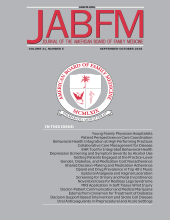Abstract
Introduction: The objective of this study was to better understand the relationship between panel size, full-time status, and estimated socioeconomic status of a patient panel with types and number of primary care clinician inbox messages.
Methods: The study used data from the Epic Signal database to examine inbox volume and types of messages for 86 primary care clinicians at 19 primary care sites. We measured correlations and performed multiple regression analysis to understand the relationship between inbox volume and types of messages and 3 factors: panel size, full-time status, and estimated socioeconomic status of patient panels.
Results: The study found positive correlation between the number of messages and panel size, full-time status, and estimated socioeconomic status of patient panels. The number of patient portal messages generated from patient panels with higher socioeconomic status accounted for the positive correlation in total inbox messages and that factor.
Discussion: These findings contribute to our understanding of primary care workload, specifically as it relates to panel size, full-time status, and patient panel socioeconomic status. Increase in clinical time or panel size needs to come with trained team members or additional time to address inbox messages.
Introduction
Primary care physicians (PCPs) commonly have inbox message volumes that account for more than an hour of additional work per day.1,2 However, less is known about the specific types of inbox messages and whether inbox message volume and type vary by panel size, full-time equivalent (FTE) status, and estimated socioeconomic status of a physician's patient panel.
Methods
We performed a retrospective analysis of inbox volume and type of messages received by PCPs in an academic health care system in Northeast Ohio. We retrieved data for each physician in our system for the period of December 2015 to May 2017 from the Epic Signal database (Epic Systems Corporation). Physicians included were family medicine, internal medicine, medicine-pediatrics, and pediatrics. Data for resident physicians and advanced practice providers were not available. This database summarizes the total number of inbox messages categorized by type during quarterly 3-week periods.
We geocoded patient addresses to obtain American Community Survey estimates of median income at the census block-group level and calculated the average median income for each primary care physician's patient panel.
We examined the associations between the number of inbox messages and the number of patients attributed to a PCP (panel size), the PCP's FTE value, and the estimated average median income of the PCP's panel. We used Spearman's correlation to evaluate pairwise relationships. We then performed partial correlations and multiple linear regression analysis to provide adjusted effects with 5 metrics in the model (panel size, FTE, estimated patient panel income, physician gender, and physician years employed at MetroHealth). The MetroHealth Institutional Review Board approved the study.
Results
Our study sample included 86 PCPs and 19 practice sites. PCPs devoted 0.69 clinical FTE on average to their own primary care time. The mean panel size was 1127 total patients, not adjusted for FTE or other factors. The average median annual income for a panel was $43,264. The mean total messages received in each PCP's inbox over a 3-week period was 802 (SD = 451). The mean number of messages weighted to 1.0 FTE per PCP was 1255 (SD = 580); this averaged to 84 messages per weekday per 1.0 FTE.
The most frequent message types were test results (18%), phone refill requests (14%), other patient calls (13%), carbon-copy charts (8%), covered work (6%), patient-portal advice requests (5%), and chart cosign requests (5%). The covered work message type generates when another clinician handles the messages of a clinician who is on vacation or sick leave. The remaining message types occurred at <5% each and included addendums, staff messages, patient-portal refill requests, and nurse triage encounters.
The total number of messages received was associated with greater clinician panel size (ρ = 0.75), FTE (ρ = 0.59), and patient panel estimated income (ρ = 0.23). In multiple regression analysis, these 3 metrics remained independently associated with the total number of messages received, and along with 2 demographic covariates (see Table 1) accounted for more than half of the variability in inbox volume (R2 = 0.56; adjusted R2 = 0.53).
Multiple Linear Regression Analysis of Total Number of Messages Received*
Receipt of patient-portal advice requests was positively correlated with the estimated average median income of a PCP's panel (ρ = 0.53), and adjustment for panel size strengthened this correlation (partial ρ = 0.68). Positive unadjusted correlations between estimated average median income and patient calls (ρ = 0.36) and results (ρ = 0.13) existed but were not as strong.
Discussion
Since the widespread adoption of the electronic medical record, managing a clinical inbox has become a regular part of clinician workflow. Unique to this study, we found that managing a larger patient panel, working more days per week in primary care, and caring for wealthier patients are all factors associated with greater inbox message volumes. In addition, we confirmed findings from prior studies that PCPs still receive a large volume of total messages per day.3⇓–5 A major limitation of our study was that we did not have additional patient demographic data to put into our model to better understand whether other factors are associated with inbox volume and type variability. However, the 5 metrics we used did account for more than half of the variability. A further limitation is that we did not measure clinician time spent per message and per message type. As clinicians, we recognize that not all messages are created equal. Future studies could explore the impact of including patient demographic data and studying factors that impact time spent per message.
As primary care transitions from volume- to value-based reimbursement, we need to ensure enough time for health care teams to work together to address patient care issues that occur outside of the face-to-face visit—including inbox management. The workload of primary care is transforming, whether or not our teams and schedules keep up with the change.
Acknowledgments
This research was presented at the Society of General Internal Medicine Annual Meeting as an oral presentation on April 12, 2018, in Denver, CO.
Notes
This article was externally peer reviewed.
Conflict of interest: DG reports a book royalty agreement with Taylor & Francis.
To see this article online, please go to: http://jabfm.org/content/33/3/460.full.
- Received for publication October 6, 2019.
- Revision received December 17, 2019.
- Accepted for publication January 3, 2020.






